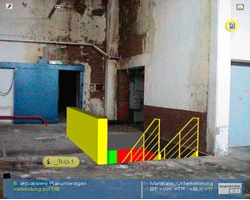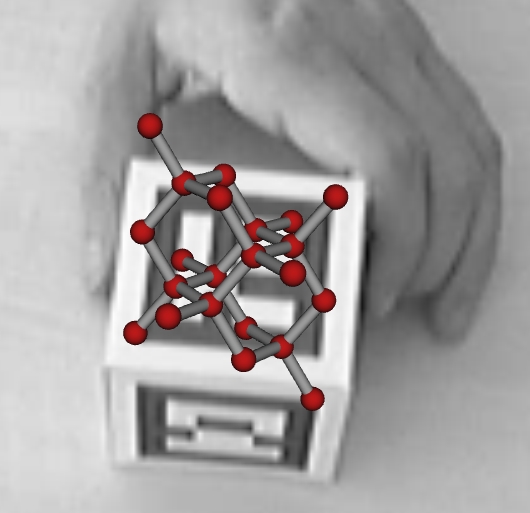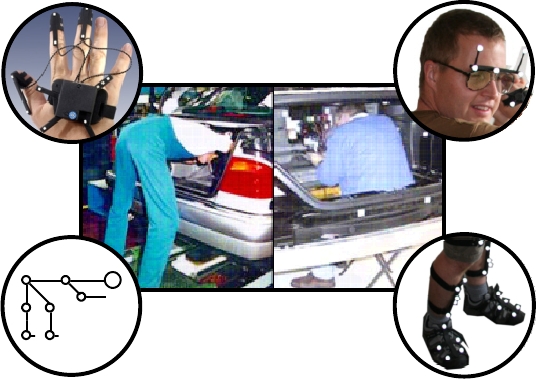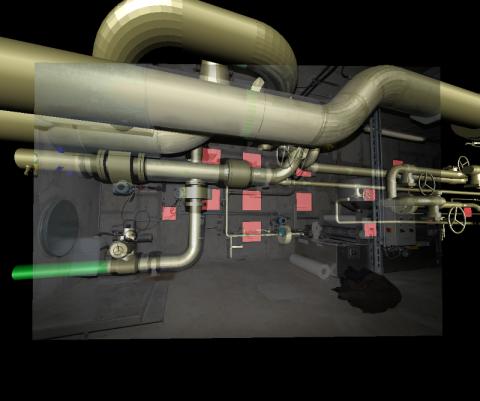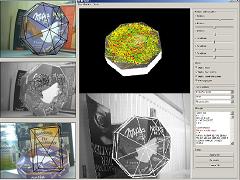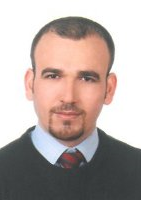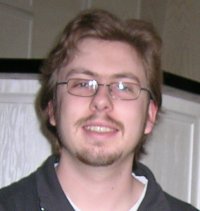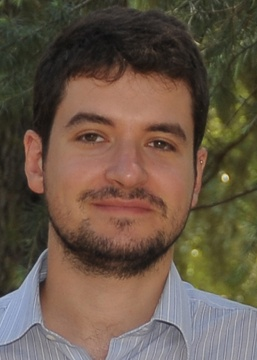Industrial Augmented Reality
Table of Content
Abstract
Within this group, we try to bring Augmented Reality to the Industry. From the lab setup to real application, there is lots of work to do from finding new application, to make in user-friendly including the robustness and the precision. To achieve this goal, we are working in close relation with numerous industry partners, given us the opportunity to learn from their expertise and the chance to do challenging research.Contact Person and Group Coordination
|
|
|
Nassir Navab |
|
|
Research Projects in Industrial Augmented Reality
ARCHIE - Augmented Reality Collaborative Home Improvement EnvironmentFor producing buildings in a collaborative way with all involved persons, ARCHIE (Augmented Reality Collaborative Home Improvement Environment) shall be responsible for giving the system user the most familiar way to h andle the information during the development process. |
Project: Forlog (Supra-adaptive Logistic Systems)The focused view on human resources within supra-adaptive logistics systems leads to the fundamentals of / establishes the fundamentals for the mobility of knowledge and the flexibility of employees. |
Augmented ChemistryThe aim of this project is to help chemists to create, visualize molecules and chemical reactions. It will be possible to see if molecules have enough space to react with eachother. The molecules are rotated and placed with markers in the real world and displayed on a monitor or on vr-glasses. |
AsyntraA.R.T. ist ein führender Hersteller von IR-optischen Trackingsystemen für den professionellen Einsatz (www.ar-tracking.de). Ein wichtiges Einsatzgebiet von A.R.T. Trackingsystemen ist hierbei die Verfolgung und virtuelle Abbildung von Bewegungen von Personen, welche u.a. dazu verwendet wird, um ergonomische Untersuchungen durchzuführen. Diese Messaufgabe wird häufig durch Verdeckungen erschwert („line of sight Problem“). Das bisher übliche („globale“) Trackingsystem wird durch eine größere Anzahl sog. Kleiner Kameras ergänzt. Unter Kleinen Kameras sollen hier verschiedene preisgünstige Kameras verstanden werden, wie z.B. USB-Kameras oder Mobiltelefone mit Kamera-Funktion, die Messdaten auch drahtlos übertragen können. Diese Kleinen Kameras werden so angeordnet, dass sie die vom globalen Tracking schlecht einsehbaren Bereiche des Messvolumens betrachten und so auch dort ein zuverlässiges, genaues Tracking ermöglichen. Durch entsprechende automatisierte Routinen werden die Positionen dieser Kameras sozusagen im Betrieb („on the fly“) eingemessen. Damit diese Kleinen Kameras in das globale Trackingsystem eingebunden werden können, müssen die Tracking-Algorithmen so ergänzt werden, dass asynchrone Beobachtungen korrekt verarbeitet werden können. Damit können schnell ad-hoc-Setups realisiert werden, die auch in schlecht einsehbaren Bereichen zuverlässig und genau tracken können. |
AvilusErweiterung von Trackingumgebungen in Makro- und Mikroumgebungen (Avilus):Einerseits wird durch geschickte Sensorfusion der Trackingbereich auszugeweitet, wobei der Schwerpunkt in der Nahtlosigkeit im Übergang zwischen verschiedenen Trackingsystemen liegt (z.B. bei weitläufigen Logistikanwendungen). Andererseits werden mittels einer Simulationsumgebung wesentliche Einflussfaktoren bezüglich der zu erzielenden Trackinggenauigkeit für hochgenaues Tracking identifiziert. Somit können gezielt Verbesserungen eingeführt werden. |
SHEEP - The Shared Environment Entertainment PastureIn this demo, we use a multiplayer shepherding game to explore the possibilities of mutimodal, multiuser interaction with wearable computing in an intelligent environment. The game is centered around a table with a beamerprojected pastoral landscape. Players can use different intuitive interaction technologies (beamer, screen, HMD, touchscreen, speech, gestures) offered by the mobile and stationary computers. Building on our DWARF framework, the system uses peer-to-peer, dynamically cooperating services to integrate different mobile devices (including spectators laptops) into the game. |
Discrepancy Check Using Augmented RealityConstruction companies employ CAD software during the planning phase but what is finally built often does not match the original plan. The procedure of validating the model is called 'discrepancy check'. The system proposed here allows the user to easily obtain an augmentation in order to find differences between the planned 3D model and the built items. The main difference to previous body of work in this field is the emphasis on usability and acceptance of the solution. While standard image-based solutions use markers or rely on a 'perfect' 3D model to find the pose of the camera; our software uses Anchor-Plates. Anchor-Plates are rectangular structures installed on walls and ceiling in the majority of industrial edifices. We are using them as landmarks because they are the most reliable components often used as reference coordinates by constructors. Furthermore; for real industrial applications; they are the most suitable solutions in terms of general applicability. For this project we try to bring a innovative solution to the discrepancy check procedure by applying Augmented Reality. |
Vision Targeted CAD ModelsThis project investigates vision features and their intelligent application on known CAD models for pose estimation. The advantage of combining CAD models and vision features lies in the known 3D geometry of the CAD model. Exemplary vision features are e.g. SIFT features, Randomized Trees, SURF features and other well known methods. The main goal is to use such an extended CAD model for pose estimation and for tracking initialization. |
Related Publications
| 2011 | |
| S. Lieberknecht, S. Benhimane, P. Meier, N. Navab
Benchmarking Template-based Tracking Algorithms International Journal of Virtual Reality (bib) |
|
| S. Lieberknecht, Q. Stierstorfer, G. Kuschk, D. Ulbricht, M. Langer, S. Benhimane
Evolution of a Tracking System Handbook of AR (bib) |
|
| 2009 | |
| P. Georgel, S. Benhimane, J. Sotke, N. Navab
Recovering the Full Pose from a Single Keyframe IEEE Workshop on Applications of Computer Vision (WACV) , Snowbird, Utah, USA, December 7-8 2009 (bib) |
|
| S. Lieberknecht, S. Benhimane, P. Meier, N. Navab
A Dataset and Evaluation Methodology for Template-based Tracking Algorithms The 8th IEEE and ACM International Symposium on Mixed and Augmented Reality, Orlando, US, Oct. 19 - 22, 2009 (bib) |
|
| P. Georgel, P. Schroeder, N. Navab
Navigation Tools for Augmented CAD Viewing IEEE Computer Graphic and Application (CGA), special issue on 3D User Interfaces (bib) |
|
| P. Georgel, S. Benhimane, J. Sotke, N. Navab
Photo-based Industrial Augmented Reality Application Using a Single Keyframe Registration Procedure The 8th IEEE and ACM International Symposium on Mixed and Augmented Reality, Orlando, US, Oct. 19 - 22, 2009 (bib) |
|
| 2008 | |
| T. Miyashita, P. Meier, T. Tachikawa, S. Orlic, T. Eble, V. Scholz, A. Gapel, O. Gerl, S. Arnaudov, S. Lieberknecht
An Augmented Reality museum guide The 7th IEEE and ACM International Symposium on Mixed and Augmented Reality, Cambridge, UK, Sept. 15 - 18, 2008. (bib) |
|
| P. Georgel, P. Schroeder, S. Benhimane, M. Appel, N. Navab
How to Augment the Second Image? Recovery of the Translation Scale in Image to Image Registration The 7th IEEE and ACM International Symposium on Mixed and Augmented Reality, Cambridge, UK, Sept. 15 - 18, 2008. (bib) |
|
| B. Schwerdtfeger, A. Hofhauser, G. Klinker
An Augmented Reality Laser Projector using Marker-less Tracking Demonstration at 15th ACM Symposium on Virtual Reality Software and Technology (VRST), Bordeaux, France, October 27-29, 2008. (bib) |
|
| B. Schwerdtfeger, D. Pustka, A. Hofhauser, G. Klinker
Using Laser Projectors for Augmented Reality 15th ACM Symposium on Virtual Reality Software and Technology (VRST), Bordeaux, France, October 27-29, 2008, pp. 134-137. (bib) |
|
| P. Georgel, S. Benhimane, N. Navab
A Unified Approach Combining Photometric and Geometric Information for Pose Estimation British Machine Vision Conference (BMVC), Leeds (UK), September 1-4, 2008 (bib) |
|
| 2007 | |
| P. Georgel, P. Schroeder, S. Benhimane, S. Hinterstoisser, M. Appel, N. Navab
An Industrial Augmented Reality Solution For Discrepancy Check Proceedings of the 6th International Symposium on Mixed and Augmented Reality (ISMAR), Nara, Japan, Nov. 2007 (bib) |
|
| 2006 | |
| J. Platonov, H. Heibel, P. Meier, B. Grollmann
A mobile markerless AR system for maintenance and repair. The Fifth IEEE and ACM International Symposium on Mixed and Augmented Reality, Santa Barbara, CA, USA, Oct. 22 - 25, 2006. (bib) |
|
| T. Blum, O. Häberle, M. Appel, H. Krcmar
Estimating the Financial Consequences of Using Augmented Reality in the Construction of Power Plants Dritter Workshop Virtuelle und Erweiterte Realität der GI-Fachgruppe VR/AR, Koblenz, Germany, September 2006 (bib) |
|
| O. Häberle, T. Blum, H. Krcmar
Evaluating an Innovative Technology in the Presence of Uncertainty 12th Americas Conference on Information Systems (AMCIS 2006), Acapulco, México, August 2006, pp. 541-549 (bib) |
|
Working Group
|
|
|
|
|
